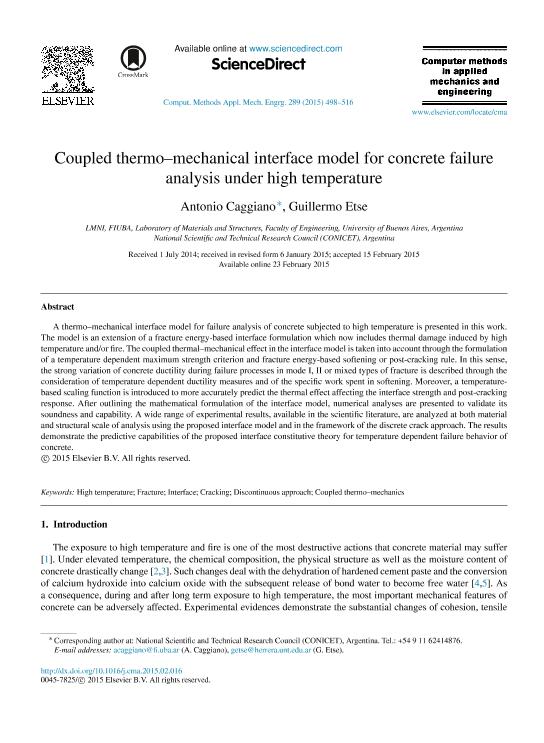Mostrar el registro sencillo del ítem
dc.contributor.author
Caggiano, Antonio

dc.contributor.author
Etse, Jose Guillermo

dc.date.available
2017-01-31T21:15:27Z
dc.date.issued
2015-06
dc.identifier.citation
Caggiano, Antonio; Etse, Jose Guillermo; Coupled thermo–mechanical interface model for concrete failure analysis under high temperature; Elsevier Science Sa; Computer Methods In Applied Mechanics And Engineering; 289; 6-2015; 498-516
dc.identifier.issn
0045-7825
dc.identifier.uri
http://hdl.handle.net/11336/12284
dc.description.abstract
A thermo–mechanical interface model for failure analysis of concrete subjected to high temperature is presented in this work. The model is an extension of a fracture energy-based interface formulation which now includes thermal damage induced by high temperature and/or fire. The coupled thermal–mechanical effect in the interface model is taken into account through the formulation of a temperature dependent maximum strength criterion and fracture energy-based softening or post-cracking rule. In this sense, the strong variation of concrete ductility during failure processes in mode I, II or mixed types of fracture is described through the consideration of temperature dependent ductility measures and of the specific work spent in softening. Moreover, a temperature-based scaling function is introduced to more accurately predict the thermal effect affecting the interface strength and post-cracking response. After outlining the mathematical formulation of the interface model, numerical analyses are presented to validate its soundness and capability. A wide range of experimental results, available in the scientific literature, are analyzed at both material and structural scale of analysis using the proposed interface model and in the framework of the discrete crack approach. The results demonstrate the predictive capabilities of the proposed interface constitutive theory for temperature dependent failure behavior of concrete.
dc.format
application/pdf
dc.language.iso
eng
dc.publisher
Elsevier Science Sa

dc.rights
info:eu-repo/semantics/openAccess
dc.rights.uri
https://creativecommons.org/licenses/by-nc-nd/2.5/ar/
dc.subject
High Temperature
dc.subject
Fracture
dc.subject
Interface
dc.subject
Cracking
dc.subject.classification
Ingeniería de los Materiales

dc.subject.classification
Ingeniería de los Materiales

dc.subject.classification
INGENIERÍAS Y TECNOLOGÍAS

dc.title
Coupled thermo–mechanical interface model for concrete failure analysis under high temperature
dc.type
info:eu-repo/semantics/article
dc.type
info:ar-repo/semantics/artículo
dc.type
info:eu-repo/semantics/publishedVersion
dc.date.updated
2017-01-31T18:29:48Z
dc.journal.volume
289
dc.journal.pagination
498-516
dc.journal.pais
Países Bajos

dc.journal.ciudad
Amsterdam
dc.description.fil
Fil: Caggiano, Antonio. Universidad de Buenos Aires. Facultad de Ingenieria. Laboratorio de Metodos Numericos En Ingenieria; Argentina. Consejo Nacional de Investigaciones Científicas y Técnicas; Argentina
dc.description.fil
Fil: Etse, Jose Guillermo. Universidad de Buenos Aires. Facultad de Ingenieria. Laboratorio de Metodos Numericos En Ingenieria; Argentina. Consejo Nacional de Investigaciones Científicas y Técnicas; Argentina
dc.journal.title
Computer Methods In Applied Mechanics And Engineering

dc.relation.alternativeid
info:eu-repo/semantics/altIdentifier/doi/http://dx.doi.org/10.1016/j.cma.2015.02.016
dc.relation.alternativeid
info:eu-repo/semantics/altIdentifier/url/http://www.sciencedirect.com/science/article/pii/S0045782515000651
Archivos asociados
